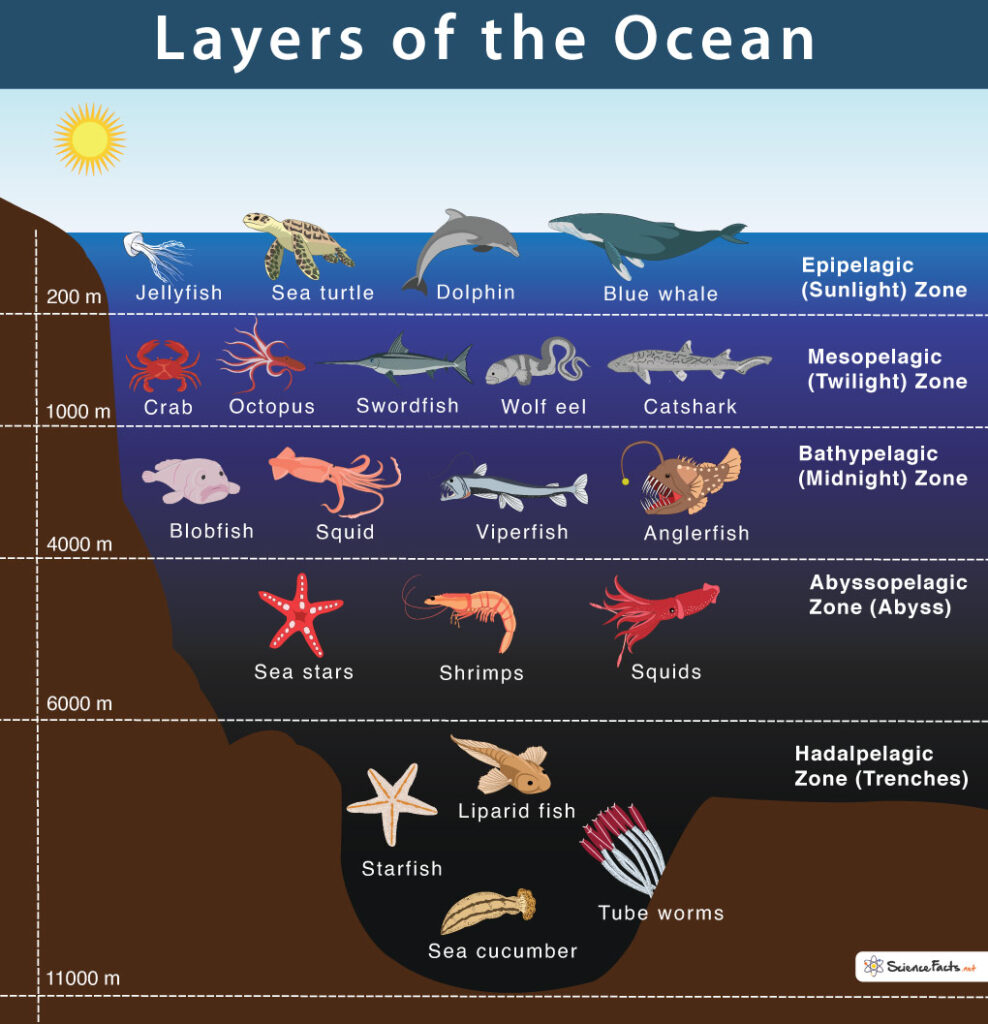Five different basins comprise the world ocean: Pacific, Atlantic, Indian, Southern, and the Arctic. With an average of 3,700 meters depth, the ocean is divided into several zones. The process of dividing it into layers is called ocean layering.
What are the Different Layers of the Ocean
- Epipelagic Zone (Sunlight Zone)
- Mesopelagic Zone (Twilight Zone)
- Bathypelagic Zone (Midnight Zone)
- Abyssopelagic Zone (The Abyss)
- Hadalpelagic Zone (The Trenches)
1) Epipelagic Zone (Sunlight Zone)
Depth: Surface to 200 meters (660 feet) It is the ocean’s surface layer, covering roughly 5 percent of the ocean’s average depth. It is named so because most visible light can penetrate this layer, making it the warmest of all layers. Its temperature is widely variable, ranging from 97°F (36°C) in the Persian Gulf to 28°F (-2°C) close to the North Pole, which is due to the invariable penetration of sunlight heating the water body. Interaction with the wind keeps the temperature under control by allowing the sun’s heat to be distributed vertically. Due to the light and warmth, this layer is full of life. Seaweeds, coral reefs, and marine animals such as dolphins, blue whales, sea turtles, and jellyfish are all found in the epipelagic zone. The sunlight allows seaweeds such as algae to perform photosynthesis, creating roughly 50 percent of the atmospheric oxygen. At the bottom of the epipelagic zone starts the thermocline. In this transitional region, the water temperature decreases rapidly with increasing depth. The depth and temperature of the thermocline vary between seasons and years.
2) Mesopelagic Zone (Twilight Zone)
Depth: 200 meters (660 feet) to 1,000 meters (3,300 feet) Also, sometimes called the midwater zone, it is found below the epipelagic zone. Only faint sunlight reaches this zone. Due to lack of light, it is from this zone that bioluminescence begins to appear from living creatures. Temperature changes are most extreme in this zone as this is the zone that contains the thermocline. The mesopelagic zone is the home to a great diversity of some strangest sea animals such as octopus, crab, krill, swordfish, wolf eel, and catshark. Despite bursting with aquatic life, this layer has remained relatively untouched from commercial fishing. No plants grow within this layer, so creatures either feed by filtering the water or hunting other creatures. Humans can dive to this layer but need to wear protective suits due to high pressure and lack of heat.
3) Bathypelagic Zone (Midnight Zone)
Depth: 1,000 meters (3,300 feet) to 4,000 meters (13,100 feet) Found below the mesopelagic zone, it makes up almost 90 percent of the ocean. It is also called the midnight zone because of the complete absence of light or, in other words, due to constant darkness. The only light found in this layer is obtained from animals’ bioluminescence, which they utilize in search of their food. The bathypelagic zone temperature is constant, which is around a chilling 39°F (4°C). The pressure in this zone is extreme and, at a depth of 4,000 meters (13,100 feet), attains over 5850 pounds per square inch. Very few creatures are found at this depth. Organisms such as plankton, blobfish, squid, viperfish, and anglerfish are some of the examples. Sperm whales are found to dive down this level in search of food.
4) Abyssopelagic Zone (The Abyss)
Depth: 4,000 meters (13,100 feet) to 6,000 meters (19,700 feet) Also called the abyssal zone, it is the pitch-black bottom layer of the ocean as no sunlight reaches this layer. The term ‘abyss’ was derived from a Greek word meaning ‘no bottom’ because they thought the ocean to be bottomless. It is covered with thick layers of mud, sand, and rocks made from dead plants and animals’ remains. Three-quarters of the deep ocean floor lies in this zone. The water temperature is near freezing, and only a small number of creatures are found at such depths. The organisms found here are transparent, blind invertebrates, such as sea stars, shrimps, and squids.
5) Hadalpelagic Zone (The Trenches)
Depth: 6,000 meters (9,700 feet) to the extreme bottom at 10,994 meters (36,070 feet) in the Mariana Trench of the Pacific Ocean in Japan It is the ocean’s deepest zone, found below the abyss in deep-sea trenches and canyons. The Mariana Trench is so deep that even Mount Everest would be wholly submerged if placed at its bottom. The temperature here is marginally above freezing, and no natural light reaches this zone. The pressure is an incredible eight tons per square inch, which almost equals the weight of 48 Boeing 747 jets. Even at such high-pressure starfish, sea cucumber, liparid fish, and tube worms are found to thrive. Abyssobrotula galatheae, an eel species, was discovered at a depth of 8,372 meters in the Puerto Rico Trench in 1970.
